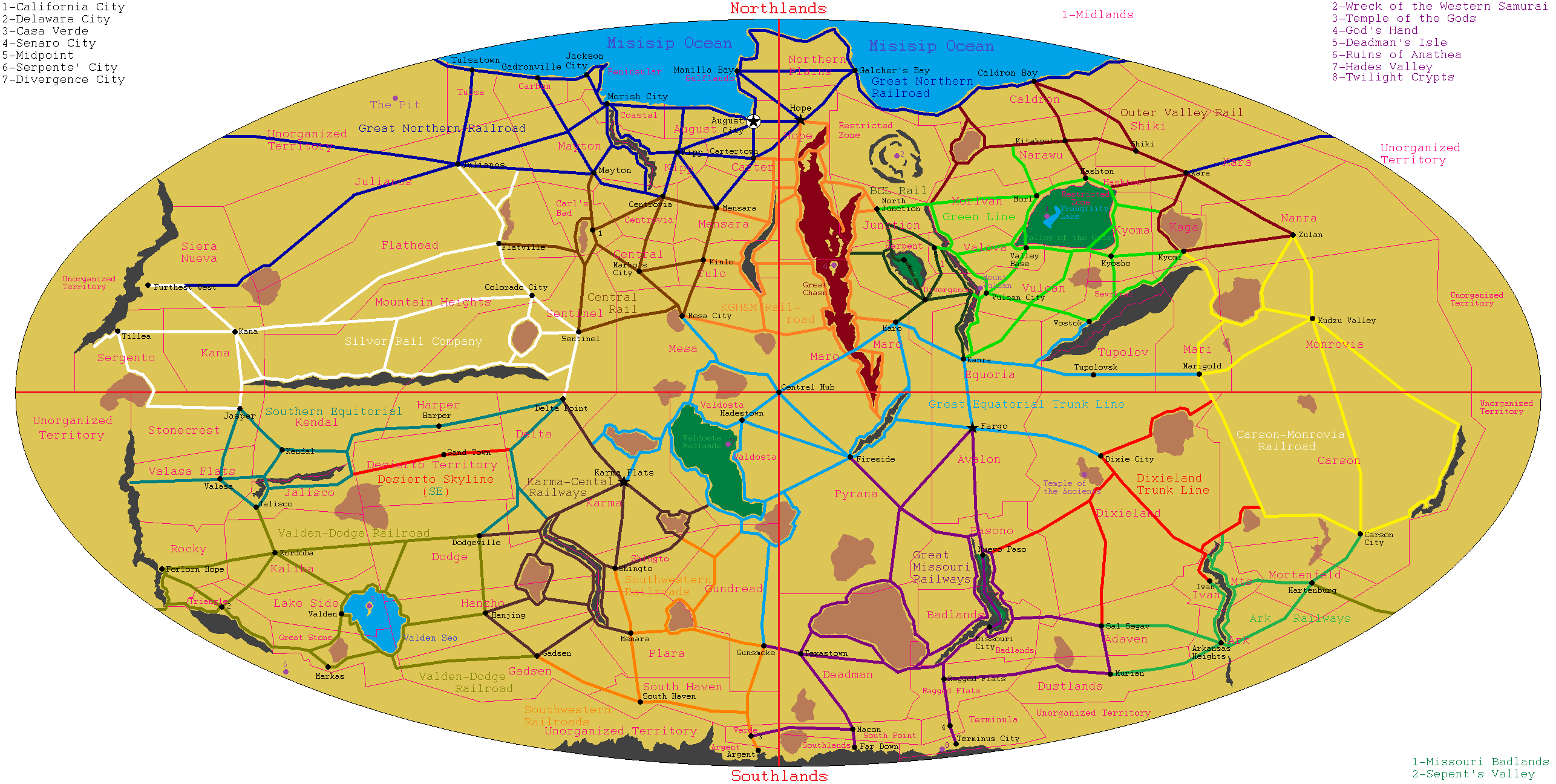HOME | DD
 tylero79 — Sagwornoh Railmap
tylero79 — Sagwornoh Railmap

#map #maps #rail #railroads #rails #railway #railways #scifi #sagwornoh #railroad #sciencefiction
Published: 2021-01-13 06:14:41 +0000 UTC; Views: 3630; Favourites: 10; Downloads: 1
Redirect to original
Description
A map of the rail system of Sagwornoh-www.deviantart.com/tylero79/ar…-----
Great Northern Railroad
Gauge-5 ft 6 in (1,676 mm), Northern/"Standard" Gauge
Originally built to connect the cities on the coast of the northern Misisip Ocean, the Great Northern eventually expanded southwards to connect August City with the other major population centers in the Great Northern States. The Great Northern Railroad at one point controlled the Central States Rail Company, but it eventually broke off as a fully independent entity. The Great Northern Railroad's almost excusive use of 5 ft 6 in rail gauge has led to much of the planet calling that gauge "Northern Gauge", while the company prefers the term "Standard Gauge" since the authorities in August City dictated that that would be the planet wide standard, despite almost only two other rail companies using it and the a complete lack of will to re-gauge the planet's vast rail network.
Central States Rail Company (Central Rail)
Gauge-5 ft 6 in (1,676 mm), Northern/"Standard" Gauge
Originally a subsidiary of the Great Northern before breaking free, the Central States Rail Company, or simply just Central Rail, serves the majority of the Five States region of the northwest and the northern portion of the state of Sentinel. Due to its long history of being a subsidiary of the Great Northern, the overwhelming majority of Central Rail's network is built to the same gauge as the Great Northern.
Silver Rail Company
Gauge-5 ft 8 in (1,727 mm), Valden Gauge
The Silver Rail Company came about as a result of a merger between the Sentinel Central-Equatorial Railroad, the Sentinel-Colorado Line, and the Flathead-Kana Railroad. The three companies were bitter rivals through out much of their histories. The only reason they came together at all was to save themselves from being absorbed by the Great Northern after it had taken full control of the Julianos-Western Trunk Line. To prevent a hostile takeover by the Great Northern, the New West Rail Company decided to re-gauge its entire network to the Valden Gauge more commonly used in the planet's southwest. The company renamed itself after a massive silver rush in southern Mountain Heights lead to a bit of a boom period for the company as it made a tremendous amount of money transporting supplies and people to the mines and silver out of the hills and to the cities, at a massively inflated mark up (at one point it was nearly at 5,000% which only lead to the Equatorial Miners Revolt which destroyed several engines and hundreds of miles of track). While the Northwestern Silver Rush has mostly calmed down, transporting silver out of Mountain Heights and southern Sentinel, along with new iron mines in Sergento and Siera Nueva keep the company as profitable as ever. While plans have been drawn up to construct an east-west line between Tillea in Sergento and Kudzu Valley in Monrovia, the vast expanse of depopulated lands makes this an unappealing prospect for the company at the moment, at least until more people start to settle the areas.
Kinlo, Great Chasm, Hope, & Maro (KGH&M) Railroad
Gauge-6 ft 2 in (1,880 mm), Chasm/"That" Gauge
Originally founded as the Hope to Maro Railroad, the company grew to basically extended all around the Great Chasm, a massive canyon in the planet's northeast. The company saw that the Great Northern Railroad and the Great Equatorial Trunk Line weren't expanding into the state of Maro, nor were they trying to connect the Five States cities of Kinlo and Mensara, so it quickly seized the opportunity before either company could. An iron rush in the Great Grant Mountains (the mountains in the eastern parts of the states of Kulo and Mensara) caused the railroad to expand to surround the perimeter of the mountains and south to Mesa City. The company's choice of 6 ft 2 in gauge has been seen by many as a mistake, as while it allows, barely, for dual gauge trackage with the Great Northern Railroad (albeit few of the KGH&M's rail network is dual-gauged), and completely unable to be dual gauge with the 6 ft track used by the Great Equatorial Trunk Line or BCL. The result is most pronounce in Mesa City, the only place on the planet were three track gauges meet, creating what many in the railroad industry call the "Mesa City Nighmare".
Bankes, Causewell, and Loome Rail Company (BCL Rail)
Gauge-6 ft (1,829 mm), Valley/Equatorial Gauge
BCL was founded by three investors who felt that KGH&M Railroad, the Great Equatorial Trunk Line, and the Green Line were ignoring the states of Serpent, Midlands, and Divergence. Together the three pooled together their money and drew in more investors, before finally completing the company's first section of track from North Junction to Divergence City. The company grew as a bit of a quasi-feeder line between the Great Equatorial Trunk and Green Lines, while still maintaining independence from them. Still a good amount of the company's profits comes directly from through traffic between the Great Equatorial Trunk and Green Lines.
Valley Basin Railroad Company (Green Line)
Gauge-6 ft (1,829 mm), Valley/Equatorial Gauge
While officially and originally incorporated as the Valley Basin Railroad Company, almost no one calls it that anymore, most just simply call it the "Green Line". Built to serve the cities of Morl, Hashton, Kyosho, and Valley Base, it later expanded to connect Vulcan City, Kanra, Vostok, North Junction, and Kyomi with its network. The Green Line gained its name from the annual "Green Rush", a time of the year when timber companies are allowed to harvest the forests of the Valley of the Gods for one month. While the governments of the Valley States would like to keep the Valley open to logging year-round, the Valley prevents that from happening. When the Green Line tried building a section of rail through the forests of the valley to shorten the Morl to Valley Base line, the entire work force disappeared without a trace, along with any rail laid 25 miles into the depths of the forest. The company spent decades trying to complete this project, until it figured out that for only one month of the year, it is safe to stay in the forest. To keep the rail lines from disappearing, the company spent a fortune building an elevated rail line. The company did the same in the Valley's southeast, building a nearly thousand mile stretch of elevated rail to shorten travel times between Vulcan City and Haston, but few use this line, as many complain about hearing voices throughout the journey above the forests, and some rail crews refuse to even go through it at all. Still the line sees some use from express shipping, to thrill seekers.
Outer Valley Rail
Gauge-5 ft 6 in (1,676 mm), Northern/"Standard" Gauge/6 ft (1,829 mm), Valley/Equatorial Gauge (most of its rail is dual-gauged)
The Outer Valley Rail was first founded as a subsidiary of the Great Northern Railroad (hence its choice of track gauge) to connect its main line along the coast of the Misisip Ocean with the Green Line to the south. Eventually the line was bought out by a consortium of businesses in Kara, who bought it because they felt like Great Northern wasn't investing enough in the lines that weren't directly connected with the Valley. While the majority of the company's rolling stock is built for Northern Gauge, the majority of the Outer Valley Rail is dual gauge to allow the Green Line to quickly pass through without having to waste time exchanging its bogies. As a result of this much of the northern portions of the Green Line, as well as the Haston to Kyosho, and Kyosho to Kyomi Lines are dual gauged as well.
Carson-Monrovia Railroad
Gauge-6 ft 6 in (1,980 mm), Carson Gauge
Built as an independent line between Carson City in the state of Carson in the southeast to Kudzu Valley in the state of Monrovia in the northeast, before expanding north to Zulan in the state of Nanra and connecting to the Outer Valley Rail, northwest to Kyomi in Kaga and the Green Line, and west to Marigold in Mari, connecting with the Great Equatorial Trunk Line, the Carson-Monrovia Railroad uses a unique gauge. As the two states lacked any rail connections at the time, its founder decided to base the rail line's gauge after his lucky number, 66, hence 6 foot, six inches. This had led to an interesting set of break of gauges, with the Green Line and the Great Equatorial Trunk Line being six inches narrower, the Dixieland Trunk Line being 2 inches narrower, the Outer Valley Rail being a whole foot narrower, and the Ark Railways being six inches broader. With the exception of its lines between the major cities, most of the Carson-Monrovia Railroad serves freight traffic, with the occasional and intermitted passenger services.
Great Equatorial Trunk Line
Gauge-6 ft (1,829 mm), Valley/Equatorial Gauge
Founded in the Central Hub, the Great Equatorial Trunk Line held a near monopoly on north-south trade throughout the planet until the Central Hub Convention forced it to sell off what would later become Southern Equatorial and forced it to abandon, for the time being, its plans for an east-west equatorial rail line. Due to its unique location, the Great Equatorial Trunk Line makes much of its money on through traffic passing through the Central Hub.
Dixieland Trunk Line
Gauge-6 ft 4 in (1,930 mm), Dixieland Gauge
Much like the Carson-Monrovia Railroad, the Dixieland Trunk Line was built independently from the other major rail networks. As such it chose its own gauge , of 6 foot, 4 inches. While its section of rail lines from Dixie City to the Carson-Monrovia Railroad is dual gauge with the Great Equatorial Trunk Line's 6 foot gauge, the rest of its network is not, solely being its unique 6 foot, 4.
Great Missouri Railroad
Gauge-7 ft (2,134 mm), Southern/Missouri Gauge
Founded in Missouri City, in the state of the Badlands, hence its name, the Great Missouri Railroad quickly expanded by absorbing other rail lines, or driving them out of business through extensive price wars. As a result, the Great Missouri Railroad controls much of the rail network in the southeast.
Ark Railways
Gauge-7 ft (2,134 mm), Southern/Missouri Gauge
The only company able to stave off acquisition by the Great Missouri Railroad, the Ark Railways gets it name from the state of Ark. The states of Ivan Mountains and Mortenfeld were originally part of Ark before being split off years later. The Ark Railways maintains a strategic stretch of lines between the Great Missouri and the Carson-Monrovia and Valden-Dodge Railroads. As a result the Ark Railways is able to use this to its advantage against the Great Missouri as it could simple just deny them passage through its tracks and force them to use it more hated rivals the Southwestern Railroads, or the Karma-Central Railways.
Southern Equatorial
Gauge-5 ft, 8 in (1,727 mm), Valden Gauge
Original a part of the Great Equatorial Trunk Line before it was forced to be split off, Southern Equatorial has for the most part behaved much like the company its broke off from. After the Silver Rail Company decided to convert to Valden Gauge, Southern Equatorial was forced to due the same, otherwise it would create a break in gauge between the Silver Rail and the Valden-Dodge Railroad. Since it controls many of the north-south lines between the northwest and the southwest, Southern Equatorial makes a lot of money from through traffic. One unique feature of Southern Equatorial is the Desierto Skyline, a several thousands mile long stretch of elevated rail through the Desierto Territory. Much of the Desierto Territory can best be described as being like quicksand, so the Skyline was an extremely expensive project as pylons had to be placed several thousand feet into the sand to hit bedrock. The only reason they built the line in the first place was to take advantage of the regions rich oil deposits and to prevent the Karma-Central Railways from doing the same.
Karma-Central Railways
Gauge-7 ft (2,134 mm), Southern/Missouri Gauge/5 ft, 8 in (1,727 mm), Valden Gauge
Founded to connect the city of Karma Flats with the rail networks in the all around the state of Karma. The Karma-Central had originally intended to expand all the way to the Valden Sea to the southwest and northeast to the Central Hub, and to connect with the Great Missouri Railroad (hence the rail gauge), but the Valden-Dodge Railroad and the Great Equatorial Trunk Line prevented these plans. It did manage to connect with the Great Missouri (which the two, later three companies would see each other as rivals) in the southeast, but these lines would later break off into the Southwestern Railroads Company. A decent portion of the Karma-Central rail network is dual gauged. The Karma Flats-Delta Point Line, the Karma Flats-Dodgeville, and the Hanjing-Gadsen Line, along with much of the rail infrastructure west of the state of Karma is dual gauge, using the company's 7 foot Missouri/Southern Gauge, and the Valden-Dodge's 5 foot 8 inches Valden Gauge. From Karma Flats, down southeast towards the state of Valdosta, much of the rail network is dual gauge, using again the company's 7 foot Missouri/Southern Gauge and the Great Equatorial Trunk Line's own 6 foot Equatorial/Valley Gauge.
Southwestern Railroads Company (Southwestern Railroads)
Gauge-7 ft (2,134 mm), Southern/Missouri Gauge
Originally a part of the Karma-Central Railways before breaking off from it, the Southwestern serves as a major transport connecting the southeast and the southwestern region of the planet. When it was a part the Karma-Central, it was engaged in a bitter price war with the Great Missouri, and to this day the two companies remain bitter rivals.
Valden-Dodge Railroad
Gauge-5 ft, 8 in (1,727 mm), Valden Gauge
The company that created the Valden Gauge. The Valden-Dodge Railroad was originally founded to connect the many cities and towns along the Valden Sea (the second largest body of freshwater on the planet's surface) with each other. From their it expanded all over the southwest, even expanding towards Hartenburg in the southeast, creating one of the two east-west routes on the planet, although this route has a break of gauge (between three other rail companies, the Southwestern Railroads, the Ark Railways, and the Great Missouri, all of which use the 7 foot Missouri/Southern Gauge).

























